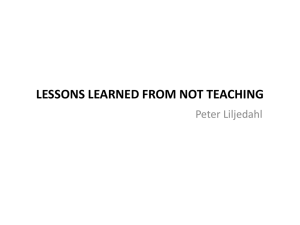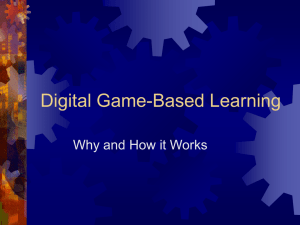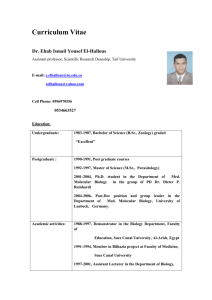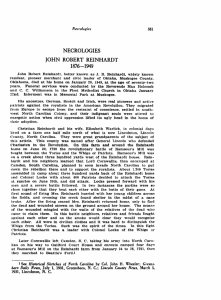Presentation
advertisement
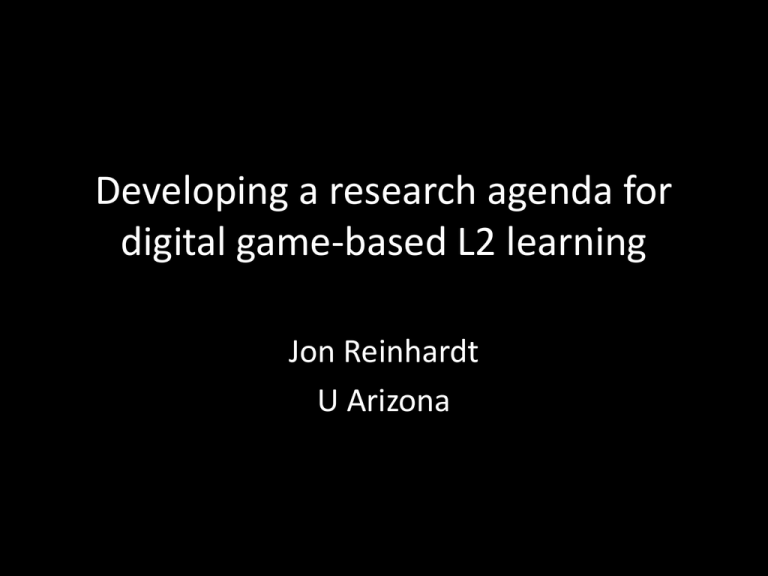
Developing a research agenda for digital game-based L2 learning Jon Reinhardt U Arizona Why games? • Digital games have grown quite popular worldwide, and are diversifying in genre types (e.g. social games, MMORPGs), audiences (e.g. older, female), design origin, even language availability (Reinhardt, 2013). • With increasing practice, more applied linguists and L2TL researchers are focusing on the area, with recent edited volumes (Reinders, 2012), special journal issues--ReCALL 24(3) by Cornillie, Thorne, & Desmet (2012), and LL&T 18(2) by Reinhardt & Sykes (in press), and monographs (Peterson, 2013; Sykes & Reinhardt, 2012) • What has been found? Are digital games effective L2 learning environments? How does one research gamemediated L2TL? Meta-analysis Research synthesis • The purpose of a meta-analysis is to synthesize results across comparable studies. • Problem: There aren’t enough well-designed, empirical, experimental, quantitative studies where ‘game-based’ is the independent variable. Also, there’s no agreement on what a ‘game’ is. • So, the purpose became to synthesize findings and identify trends in research, rather than to compare game-mediated with non gamemediated L2TL. Synthesis features • Recent: Published within last decade (2002-2012) • Inclusionary: Focus on empirical (experimental and descriptive), including pedagogical/classroom-based. • Ongoing: 35 studies identified and 28 analyzed so far, from 13 journals and several edited volumes and conference proceedings, on 10 different parameters • Parameters aligned with those used in CALL meta-analyses, e.g. functional metaphors (Levy’s tutor-tool, etc.) or SLA paradigms (Kern & Warschauer’s structural-sociocognitive, etc.) • Other parameters are unique to games, e.g. COTS vs. SIE (or enhanced vs. based; Reinhardt & Sykes, 2012), game design elements (Cornillie, Thorne, & Desmet, 2012) Parameters CALL-informed: 1. SLA approach (e.g. behaviorist, cognitive, sociocognitive) 2. Research context (e.g. formal, informal, pedagogical) 3. Research method (e.g. experimental, corpus analysis, discourse analysis) 4. Measures & instruments (e.g. pre-/post-tests, transcripts, interviews, questionnaires, game logs, observations, videos) 5. L2TL focus (vocabulary, interaction, reading, listening, speaking, culture, grammar) 6. Language (e.g. EFL, ESL, Spanish, German, etc.) Unique to digital games 7. Game function and study purpose (game-enhanced/game-based, learning/pedagogy) 8. Game genre (e.g. role play, action, adventure, simulation, MMORPG) 9. Game design element (e.g. context, narrative, collaboration, motivation) 10. Learner perception: focus of goal-orienting activity (game, player, instruction) Synthesized findings: Affordances of games in L2TL • repetition and redundancy of input (deHaan, 2005; McGraw, Yoshimoto, & Seneff, 2009; Piiranen-Marsh & Tainio, 2009) • environment for collaboration and negotiation (Hanson, 2005; Reinders & Wattana, 2012; Rama et al., 2012; Thorne & Fischer, 2012; Peterson, 2012) • increased confidence and willingness to communicate and take risks (Reinders & Wattana, 2012; Zheng et al., 2009) • co-action, languaging, and alignment (Piiranen-Marsh & Tainio, 2009; Zheng, Newgarden, & Young, 2012; Peterson, 2012) • development of : – pragmatic competence (Sykes 2009; 2010) – lexical competence (Miller & Hegelheimer, 2006; Ranalli, 2008; Verhallen & Bus, 2010; Müller, 2013) – critical and digital literacies (Lacasa, Mendez, & Martinez, 2008; Alexander, 2009; deHaan, 2011; Reinhardt & Zander, 2011) – (inter)cultural competence (Thorne, 2008; Neville, Shelton, & McInnis, 2009; O’Brien, Levy, & Orich, 2009) – narrative competence (Hanson, 2005; Holden & Sykes, 2011) Synthesized findings: Challenges and potentials • Task-based L2 pedagogy can be successfully matched with gamemediated learning (Miller & Hegelheimer, 2006; Ranalli, 2008; O’Brien, Levy, & Orich, 2009; Reinhardt & Zander, 2011). • Game texts, paratexts and attendant discourses can be linguistically diverse and highly complex (Thorne, Fischer, & Lu, 2012). • Online gaming spaces are used informally for autonomous L2 learning (Thorne & Fischer, 2012). • Students who play EFL games outside of class tend to have higher EFL proficiency than those who don’t (Sylven & Sundqvist, 2012). • In some game genres, players may focus on rules at the expense of language (deHaan, Reed, & Kuwada, 2010). • Learners may resist game-mediated L2 learning if perceived as 'nonserious' (Reinhardt & Zander, 2011). • There may be a disconnect between teacher beliefs and gamerlearner practices with regards to DGB L2 learning (Chik, 2012). Results: CALL categories Synthesis: CALL parameters Empirical research on game-mediated L2TL has: • taken a variety of approaches, about half behaviorist+ cognitive, half socio-cognitive • used a variety of methods, about half experimental, half discourse analysis (probably correlates to approach) • used mostly questionnaires, post-tests, and analysis of student work and chat transcripts (again correlating to method), with less use of game logs, game records, recorded game sessions, analysis of game texts, paratexts, and attendant discourses. • focused mostly on reading, vocabulary, and interaction, with less attention to grammar, culture, & pragmatics • focused mostly on English… Results: Game parameters Synthesis: Game-unique categories Empirical game-mediated L2TL research has also: • focused primarily on game design elements that align with L2TL tenets, like context, narrative, collaboration, motivation, and interactivity. • focused on the design of, learning with, and the pedagogy of, COTS games as well as SIEs. • worked with game genres most aligned with L2TL tenets, like MMORPGs, simulation, and adventure games Research perspective Studies seem to take one of three perspectives: 1) SLA-agnostic research focused on game-based design elements. 2) descriptive or experimental research on pedagogical integration and implementation 3) descriptions of player activity Agency is privileged in the: 1) game design 2) pedagogy or instruction 3) player-learner From synthesis to agenda: Where to start? • Which game? build, modify, or adapt? MMORPGs, simulations, adventure, role play? • Which setting? learning ‘in the wild’ or pedagogy in the classroom? • Which frameworks? socio-cognitive, cognitive, behaviorist? experimental, case studies, quantitative? • Which perspective? game, instruction, player? • Game as activity Game genre & features • Which game and which features? Is the RQ about a genre, a game title, or a feature across titles and/or genres? • Game genres are fluid and one game may mix features from a variety of genres (e.g. time pressure, narrative, feedback type, affordance for player-player interaction, etc.) • build your own game: Cornillie, Clarebout, & Desmet, 2012 (+ customization, - inauthentic) • use an existing game: Hitosugi, Schmidt, & Hayashi, 2014 (+ authentic, - many variables) • adapt an existing game: Reinders & Wattana, 2012 (+ semi-authentic, allows customization, - game may lose functional coherence) Study setting • In what setting? How does this align with other aspects of the research? • Setting will impact the generalizability and ecological validity of the findings • In classroom—as main or secondary instruction? mandatory or optional? (e.g. Reinhardt, Warner, & Lange, in press; Miller & Hegelheimer, 2006) • Formally—in experimental or lab contexts? (e.g. Sylven & Sundqvist, 2012; Peterson, 2012) • Informally—‘in the wild’, as played in everyday contexts? (e.g. Thorne, 2008; Piirainen-Marsh & Tainio, 2009) Framework • Which SLA or other theories, and which methods, should be used? • Games can be understood metaphorically as tutors, tools, or ecologies, and some game designs and features privilege particular frameworks (Reinhardt & Thorne, in press). • Game as tutor (e.g. deHaan, 2005; Miller & Hegelheimer, 2006) (e.g. simulations cognitive frameworks) • Game as tool for interaction (e.g. Zheng et al., 2009; Rama et al., 2012) (e.g. MMORPGs social frameworks) • Game as ecology (e.g. Thorne, Fischer, & Lu, 2012; Chik, 2012) (e.g. games with active communities ecological frameworks) • Game as method, a.k.a. gameful L2TL or ‘gamification’ Perspective • From which perspective(s)? Game, player, and/or instruction? • Game design: feedback, narrative, choice provision, repetition, contextualization – Which designs lead to which behaviors? Which behaviors afford what kinds of L2 learning? • Player-learner: gender, age, L2 proficiency, gaming experience/expertise, gameplay style – Who are L2 game player-learners? How do individual differences impact attitudes, motivation, and learning outcomes? • L2 Pedagogy: integration into game, curricular integration, role of teacher or curriculum, pedagogical approach (game as tutor, tool, ecology, etc.) – How can a game be integrated into formal learning contexts? How does the nature of integration impact learning? What role does instructor play? Game as activity The player-learner: • How can player-learner variables (motivation, gender, proficiency, gaming experience, gaming preferences) be examined in an ecologically valid way, i.e., without players losing agency and ‘gameful’ disposition? The game: • Which game designs, rules and narratives, afford what sorts of L2 learning, and how? What role does pedagogical mediation play? Other players: • How does the social aspect of gameplay impact learning? What designs afford what kinds and qualities of social interaction? The instruction: • What is the relationship between gaming literacies and other L2 literacies, both traditional and new? How do gaming literacies develop through naturalistic and pedagogically-mediated gameplay? The end: • What are the tensions between learning and playing? How does context of gameplay (e.g. in a classroom) impact player-learner motivation or learning outcomes? When does gameplay become ‘gamework’ in the mind of the player-learner? Needs and Opportunities • more empirical research, though not necessarily to compare game-mediated with non game-mediated, but in recognition of the increased popularity of gaming • more research focused on where game design and L2LT meet (e.g. goal orientation, feedback, interaction, motivation, narrative) • more research on digital games in L2 pedagogy (e.g. integration of COTS games, student-led game design, game-informed task design) • more focus on game-mediated L2TL as ecology (i.e. consideration of gaming as socio-literacy practice) Thank you jonrein@email.arizona.edu arizona.academia.edu/JonathonReinhardt games2teach.wordpress.com References Presentation References: • Blyth (2008). Research perspectives on online discourse and foreign language learning. In S. Magnan (ed.), Mediating Discourse Online, 47-70. • Chapelle (2009). The relationship between second language acquisition theory and computer-assisted language learning. The Modern Languages Journal, 93, 741-753. • Cornillie, F., Thorne, S., & Desmet, P. (2012). ReCALL special issue: Digital games for language learning: challenges and opportunities. ReCALL 24(3), 243256. • Filsecker, M. & Bundgens-Kosten, J. (2012). Behaviorism, constructivism, and communities of practice: How pedagogic theories help us understand game-based language learning? In H. Reinders (ed.), Digital Games in Language Teaching and Learning, 50-69. Palgrave Macmillan. • Grgurovic, M., Chapelle, C. & Shelley, M. (2013). A meta-analysis of effectiveness studies on computer technology-supported language learning. ReCALL 25(2), 165-198. • Kern, R., & Warschauer, M. (2000). Introduction: Theory and practice of network-based language teaching. In M. Warschauer, & R. Kern (Eds.), Network-based language teaching: Concepts and practice, 1–19. Cambridge: Cambridge University Press. • Lam, W. S. E. & Kramsch, C. (2003). The Ecology of an SLA Community in Computer-Mediated Environments. In J. Leather & J. van Dam (Eds.), Ecology of Language Acquisition. Dordrecht, The Netherlands: Kluwer Publishers. • Levy, M. (1997) Computer-Assisted Language Learning: context and conceptualization. Oxford: Clarendon Press. • Meskill, C. (2005). Metaphors that shape and guide CALL research. In J. Egbert & G. M. Petrie (Eds.), CALL research perspectives (pp. 25-40). Mahwah, NJ: Lawrence Erlbaum. • Norris, J. & Ortega, L. (2006). Synthesizing research on language teaching and learning. Philadelphia: John Benjamins. • • • • • • • • • • Peterson, M. (2010). Massively multiplayer online role-playing games as arenas for second language learning. CALL, 23(5), 429-439. Reinders, H. (Ed.) (2012). Digital games in language teaching and learning. New York: Palgrave Macmillan. Reinhardt, J. & Sykes, J. (2012). Conceptualizing digital game-mediated L2 learning and pedagogy: game-enhanced and game-based research and practice. In H. Reinders (ed.), Digital Games in Language Learning and Teaching. New York: Palgrave Macmillan. Reinhardt, J. (2012). "Accommodating divergent frameworks in analysis of technology-mediated interaction". In M. Dooly and R. O’Dowd (Eds.), Researching Online Interaction and Exchange in Foreign Language Education: Current Trends and Issues, 45-77. Frankfurt: Peter Lang. Reinhardt, J. (2013). “Digital game-mediated foreign language teaching and learning: Myths, realities, and opportunities”. In C. Brudermann, P. Faure, & M. Derivry (Eds.), Language Learning in the 21st Century. Marseille: Riveneuve. Sykes, J. & Reinhardt, J. (2012). Language at Play: Digital Games in Second and Foreign Language Teaching and Learning. New York: Pearson. Warschauer, M., & Healey, D. (1998). Computers and language learning: An overview. Language Teaching, 31, 57-71. Zhao, Y. (2003). Recent developments in technology and language learning: A literature review and meta-analysis. CALICO Journal 21(1): 7-27. References from Synthesis of DGBL2TL Research • Alexander.J. (2009). Gaming, student literacies, and the composition classroom: Some possibilities for transformation. College Composition and Communication 61(1), 35-63 • Chik, A. (2012) Digital Gameplay for autonomous language learning. In H. Reinders, ed., Digital Games in Language Learning, 95-114. New York: Palgrave Macmillan. • Cornillie, F., Clarebout, G., & Desmet, P. (2012). Between learning and playing? Exploring learners' perceptions of corrective feedback in an immersive game for English pragmatics. ReCALL, 24(3), 257-278. • deHaan, J. (2005). Acquisition of Japanese as a Foreign Language through a Baseball Video Game. Foreign Language Annals 38(2), 282-286. • deHaan, J., Reed, W., & Kuwada, K. (2010). The effect of interactivity with a music video game on second language vocabulary recall. Language Learning and Technology, 14(2), 74-94. • Hansson, T. (2005). ESL on a virtual platform--tradition and innovation in a new medium. Computer Assisted Language Learning, 18 (1&2), 63 – 79. • Hitosugi, C., Schmidt, M., & Hayashi, K. (2014). Digital game-based learning (DGBL) in the L2 classroom: The impact of the UN’s off-the-shelf videogame, Food Force, on learner affect and vocabulary retention. CALICO Journal 31(1), 19-39. • Holden, C. & Sykes, J. (2011). Leveraging mobile games for place-based language learning. International Journal of Gamebased Learning 1(2), 1-18. • Lacasa, P., Martínez, R. & Méndez , L. (2008). Developing new literacies using commecial videogames as educational tools. Linguistics and Education 19 (2008), 85-106. • McGraw, I., Yoshimoto, B. and Seneff, S. (2009). Speech-enabled Card Games for Incidental Vocabulary Acquisition in a Foreign Language. Speech Communication, 51(10), 1006-1023. • • • • • • • • • • • • • • • • Miller, M. & Hegelheimer, V. (2006). The SIMS meet ESL: Incorporating authentic computer simulation games into the language classroom. Interactive Technology & Smart Education (2006) 4: 311-328. Müller, A. (2012). Research-based design of a medical vocabulary videogame. International Journal of Pedagogies and Learning, 7(2), 122-134. Neville, D., Shelton, B., & McInnis, B. (2009) Cybertext Redux: Using Digital Game-Based Learning to Teach L2 Vocabulary, Reading, and Culture. Computer Assisted Language Learning, 22(5), 409–424 O’Brien, M., Levy, R., & Orich, A. (2009). Virtual Immersion: The role of CAVE and PC technology. CALICO Journal, 26(2), 337362. Peterson, M. (2012). Learner interaction in a massively multiplayer online role playing game (MMORPG): A sociocultural discourse analysis. ReCALL, 24(3), 361-380. Piiranen-Marsh, A. & Tainio, L. (2009). Other-repetition as a resource for participation in the activity of playing a video game. Modern Language Journal, 93(2), 153-169. Purushotma, R. (2005). You're not studying, you're just... Language Learning and Technology, 9(1), 80-96. Rama, Black, van Es, and Warschauer (2012). Affordances for second language learning in World of Warcraft. ReCall, 24(3), 322-338. Ranalli, J. (2008). Learning English with The Sims: exploiting authentic computer simulation games for L2 learning. Computer Assisted Language Learning, 21(5), 441–455. Reinders, H. & Wattana, S. (2012). Talk to me! Games and students’ willingness to communicate. In Reinders, H. (Ed.), Digital Games in Language Learning and Teaching, 156-188. Basingstoke: Palgrave Macmillan. Reinhardt, J. & Zander, V. (2011). Social networking in an intensive English program classroom: A language socialization perspective. CALICO Journal, 28(2), 326-344. Sykes, J. (2009). Learner Requests in Spanish: Examining the Potential of Multiuser Virtual Environments for L2 Pragmatic Acquisition. In L. Lomicka and G. Lord (Eds.) The Second Generation: Online collaboration and social networking in CALL, 2009 CALICO Monograph. San Marcos, TX: CALICO. Sylven, L., & Sundqvist, P. (2012). Gaming as extramural English L2 learning and L2 proficiency among young learners. ReCALL, 24(3), 302-321. • • • • • • Thorne, S. (2008). Transcultural communication in open internet environments and massively multiplayer online games. In Magnan, S. (ed.) Mediating Discourse Online (pp. 305-327). Amsterdam: John Benjamins. Thorne, S., & Fischer, I. (2012). Online gaming as sociable media. ALSIC 15(1). http://alsic.revues.org/2450 Thorne, S., Fischer, I., & Lu, X. (2012). The semiotic ecology and linguistic complexity of an online game world. ReCALL, 24(3), 279-301 Verhallen, M. & Bus, A. (2010). Low- income immigrant pupils learning vocabulary through digital picture storybooks. Journal of Educational Psychology, 102(1), 51-61. Zheng, D., Newgarden, K., & Young, M. (2012). Multimodal analysis of language learning in World of Warcraft play: Languaging as Values-realizing. ReCALL, 24(3), 339-360. Zheng, D., Young, M., Wagner, M., & Brewer, R. (2009). Negotiation for action: English language learning in game-based virtual worlds. Modern Language Journal, 93(4), 489-511.



